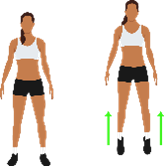Activation and Dryland Training
This information is provided for general reference only. Every swimmer's needs and abilities are unique, and exercises should be adapted to their age, physical condition, and training goals. Before starting any new exercise program, consult with a certified coach, personal trainer, or physiotherapist to ensure the exercises are safe and appropriate.
What is Activation and Why is it Important?
Activation exercises are dynamic movements designed to prepare the body for swim training or competition. They improve blood flow, activate key muscle groups, enhance mobility, and reduce the risk of injury.
Key Benefits of Activation:
- Warms up the body for peak performance in the pool.
- Activates muscles used in swimming, such as the shoulders, core, and hips.
- Enhances focus and readiness for training or racing.
Calgary Patriots Activation Routine (PDF Download)
| Exercise | Reps | Example |
|---|---|---|
| T-Spine Rotation | 10 on each side |  |
| Cat-Cow | 12 |  |
| T-Y-I’s | 10 for each Letter |  |
| Bird Dogs | 10 on each side |  |
| Pogo Jumps | 20 |  |
| Side Plank | 30 seconds on each side |  |
What is Dryland Training and Why is it Important?
Dryland training involves strength, flexibility, and conditioning exercises performed outside the pool. These exercises improve overall athleticism, strengthen swimming-specific muscles, and reduce injury risk.
Key Benefits of Dryland Training:
- Builds strength and power for starts, turns, and strokes.
- Enhances core stability, crucial for maintaining body position in the water.
- Improves flexibility and mobility for better technique.
Sample Dryland Training Program
Frequency: 2–3 times per week, focusing on proper form and gradual progression.
- Warm-Up (5–10 Minutes):
- Light jogging or skipping.
- Dynamic stretches (as listed in the activation routine).
- Strength Exercises (2–3 Sets Each):
- Push-Ups: 10–15 reps.
- Bodyweight Squats: 15 reps.
- Plank with Shoulder Taps: 20 taps (10 each side).
- Superman Hold: 30 seconds.
- Core and Stability Work:
- Russian Twists: 20 reps (10 each side).
- Dead Bug: 10 reps each leg.
- Flexibility and Cool-Down (5–10 Minutes):
- Child’s Pose: Hold for 30 seconds.
- Hamstring Stretch: Hold for 30 seconds each leg.
- Chest Opener Stretch: Hold for 30 seconds.
Special Considerations
- Young Swimmers: Focus on bodyweight exercises to build coordination and functional strength without overloading joints.
- Competitive Swimmers: Incorporate resistance training, under supervision, to develop explosive power.
- Injury Prevention: Regularly include exercises that strengthen the shoulders and core to reduce overuse injuries.
Recommended Resources
For detailed guidance, exercise demos, and tailored programs, check out these trusted resources:
By incorporating activation and dryland training into your routine, you can enhance your performance in the pool, build strength, and stay injury-free. Remember, proper form and progression are essential. Always consult your coach or a certified professional to ensure the program meets your needs.